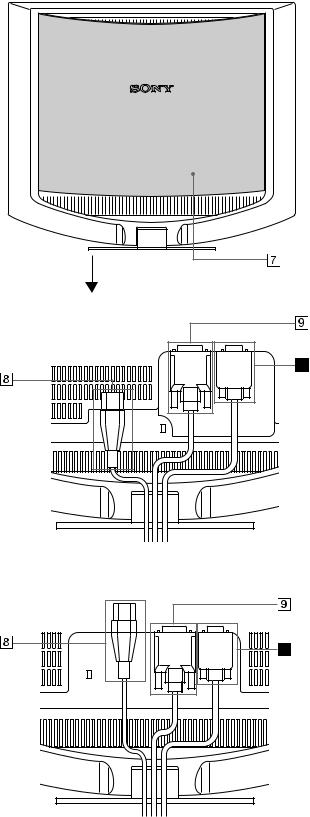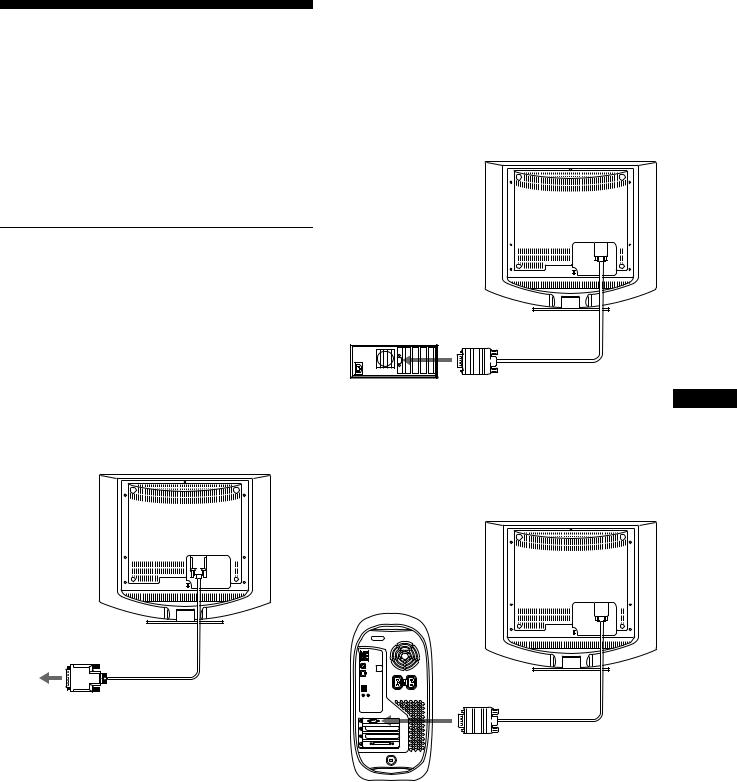Sony SDM-HS74P-S, SDM-HS94P-B, SDM-HS94P-S, SDM-HS74P, SDM-HS94P User Manual
...
2-103-459-01(1)
TFT LCD Color
Computer Display
Operating Instructions |
GB |
||
|
|
|
|
SDM-HS74
SDM-HS94
SDM-HS74P
SDM-HS94P
© 2004 Sony Corporation

Owner’s Record
The model and serial numbers are located at the rear of the unit. Record these numbers in the spaces provided below. Refer to them whenever you call upon your dealer regarding this product. Model No. Serial No.
WARNING
To prevent fire or shock hazard, do not expose the unit to rain or moisture.
Dangerously high voltages are present inside the unit. Do not open the cabinet. Refer servicing to qualified personnel only.
FCC Notice
This equipment has been tested and found to comply with the limits for a Class B digital device, pursuant to Part 15 of the FCC Rules. These limits are designed to provide reasonable protection against harmful interference in a residential installation. This equipment generates, uses, and can radiate radio frequency energy and, if not installed and used in accordance with the instructions, may cause harmful interference to radio communications. However, there is no guarantee that interference will not occur in a particular installation. If this equipment does cause harmful interference to radio or television reception, which can be determined by turning the equipment off and on, the user is encouraged to try to correct the interference by one or more of the following measures:
–Reorient or relocate the receiving antenna.
–Increase the separation between the equipment and receiver.
–Connect the equipment into an outlet on a circuit different from that to which the receiver is connected.
–Consult the dealer or an experienced radio/TV technician for help. You are cautioned that any changes or modifications not expressly approved in this manual could void your authority to operate this equipment.
IMPORTANTE
Para prevenir cualquier mal funcionamiento y evitar daños, por favor, lea detalladamente este manual de instrucciones antes de conectar y operar este equipo.
If you have any questions about this product, you may call; Sony Customer Information Services Center 1-800-222-7669 or http://www.sony.com/
Declaration of Conformity |
|
Trade Name: |
SONY |
Model: |
SDM-HS74 |
|
SDM-HS94 |
|
SDM-HS74P |
|
SDM-HS94P |
Responsible Party: |
Sony Electronics Inc. |
Address: |
16450 W. Bernardo Dr, |
|
San Diego, CA 92127 U.S.A. |
Telephone Number: |
858-942-2230 |
This device complies with part 15 of the FCC rules. Operation is subject to the following two conditions: (1) This device may not cause harmful interference, and (2) this device must accept any interference received, including interference that may cause undesired operation.
2

Table of Contents
Precautions. . . . . . . . . . . . . . . . . . . . . . . . . . . . . . . . . . . . . . . . . . . . 4
Identifying parts and controls . . . . . . . . . . . . . . . . . . . . . . . . . . . . . . 5
Setup . . . . . . . . . . . . . . . . . . . . . . . . . . . . . . . . . . . . . . . . . .7
Step 1: Connect the display to your computer . . . . . . . . . . . . . . . . . 7
Step 2: Connect the power cord. . . . . . . . . . . . . . . . . . . . . . . . . . . . 8
Step 3: Secure the cords and replace the back cover . . . . . . . . . . . 8
Step 4: Turn on the monitor and computer . . . . . . . . . . . . . . . . . . . 9
Adjusting the tilt . . . . . . . . . . . . . . . . . . . . . . . . . . . . . . . . . . . . . . . . 9
Selecting the input signal (INPUT button). . . . . . . . . . . . . . . . . . . . . 9
•Macintosh is a trademark licensed to Apple Computer, Inc., registered in the U.S.A. and other countries.
•Windows and MS-DOS are registered trademarks of Microsoft Corporation in the United States and other countries.
•IBM PC/AT and VGA are registered trademarks of IBM Corporation of the U.S.A.
•VESA and DDC are trademarks of the Video Electronics Standards Association.
•ENERGY STAR is a U.S. registered mark.
•Adobe and Acrobat are trademarks of Adobe Systems Incorporated.
•All other product names mentioned herein may be the trademarks or registered trademarks of their respective companies.
•Furthermore, “ ” and “ ” are not mentioned in each case in this manual.
http://www.sony.net/
Customizing Your Monitor . . . . . . . . . . . . . . . . . . . . . . .10
Adjusting to the desired brightness. . . . . . . . . . . . . . . . . . . . . . . . . 10 Navigating the menu. . . . . . . . . . . . . . . . . . . . . . . . . . . . . . . . . . . . 10 Adjusting the backlight (BACKLIGHT) . . . . . . . . . . . . . . . . . . . . . . 11 Adjusting the contrast (CONTRAST) . . . . . . . . . . . . . . . . . . . . . . . 12 Adjusting the black level of an image (BRIGHTNESS). . . . . . . . . . 12 GB Adjusting the picture’s sharpness and centering (SCREEN)
(analog RGB signal only) . . . . . . . . . . . . . . . . . . . . . . . . . . . . . . . . 12 Adjusting the color temperature (COLOR) . . . . . . . . . . . . . . . . . . . 13 Changing the gamma setting (GAMMA). . . . . . . . . . . . . . . . . . . . . 14 Adjusting the sharpness (SHARPNESS) . . . . . . . . . . . . . . . . . . . . 14 Changing the menu’s position (MENU POSITION) . . . . . . . . . . . . 14 Changing the input automatically (INPUT SENSING) . . . . . . . . . . 14 Selecting the on-screen menu language (LANGUAGE). . . . . . . . . 15 Additional settings. . . . . . . . . . . . . . . . . . . . . . . . . . . . . . . . . . . . . . 15
Technical Features . . . . . . . . . . . . . . . . . . . . . . . . . . . . .16
Power saving function. . . . . . . . . . . . . . . . . . . . . . . . . . . . . . . . . . . 16 Reducing the power consumption (

 mode) . . . . . . . . . . . . . . . . 16 Automatic picture quality adjustment function
mode) . . . . . . . . . . . . . . . . 16 Automatic picture quality adjustment function
(analog RGB signal only) . . . . . . . . . . . . . . . . . . . . . . . . . . . . . . . . 16
Troubleshooting. . . . . . . . . . . . . . . . . . . . . . . . . . . . . . . .17
On-screen messages . . . . . . . . . . . . . . . . . . . . . . . . . . . . . . . . . . . 17 Trouble symptoms and remedies . . . . . . . . . . . . . . . . . . . . . . . . . . 18 Self-diagnosis function . . . . . . . . . . . . . . . . . . . . . . . . . . . . . . . . . . 20
Specifications. . . . . . . . . . . . . . . . . . . . . . . . . . . . . . . . . .21
3

Precautions
Warning on power connections
•Use the supplied power cord. If you use a different power cord, be sure that it is compatible with your local power supply.
For the customers in the U.S.A.
If you do not use the appropriate cord, this monitor will not conform to mandatory FCC standards.
For the customers in the UK
If you use the monitor in the UK, be sure to use the appropriate UK power cord.
Example of plug types
for 100 to 120 V AC for 200 to 240 V AC for 240 V AC only
The equipment should be installed near an easily accessible outlet.
Installation
Do not install or leave the monitor:
•In places subject to extreme temperatures, for example near a radiator, heating vent, or in direct sunlight. Subjecting the monitor to extreme temperatures, such as in an automobile parked in direct sunlight or near a heating vent, could cause deformations of the casing or malfunctions.
•In places subject to mechanical vibration or shock.
•Near any equipment that generates a strong magnetic field, such as a TV or various other household appliances.
•In places subject to inordinate amounts of dust, dirt, or sand, for example near an open window or an outdoor exit. If setting up temporarily in an outdoor environment, be sure to take adequate precautions against airborne dust and dirt. Otherwise irreparable malfunctions could occur.
Handling the LCD screen
•Do not leave the LCD screen facing the sun as it can damage the LCD screen. Take care when you place the monitor by a window.
•Do not push on or scratch the LCD screen. Do not place a heavy object on the LCD screen. This may cause the screen to lose uniformity or cause LCD panel malfunctions.
•If the monitor is used in a cold place, a residual image may appear on the screen. This is not a malfunction. The screen returns to normal as the temperature rises to a normal operating level.
•If a still picture is displayed for a long time, a residual image may appear for a while. The residual image will eventually disappear.
•The LCD panel becomes warm during operation. This is not a malfunction.
Note on the LCD (Liquid Crystal Display)
Please note that the LCD screen is made with highprecision technology. However, black points or bright points of light (red, blue, or green) may appear constantly on the LCD screen, and irregular colored stripes or brightness may appear on the LCD screen. This is not malfunction.
(Effective dots: more than 99.99%)
Maintenance
•Be sure to unplug the power cord from the power outlet before cleaning your monitor.
•Clean the LCD screen with a soft cloth. If you use a glass cleaning liquid, do not use any type of cleaner containing an anti-static solution or similar additive as this may scratch the LCD screen’s coating.
•Clean the cabinet, panel, and controls with a soft cloth lightly moistened with a mild detergent solution. Do not use any type of abrasive pad, scouring powder, or solvent, such as alcohol or benzine.
•Do not rub, touch, or tap the surface of the screen with sharp or abrasive items such as a ballpoint pen or screwdriver. This type of contact may result in a scratched picture tube.
•Note that material deterioration or LCD screen coating degradation may occur if the monitor is exposed to volatile solvents such as insecticide, or if prolonged contact is maintained with rubber or vinyl materials.
Transportation
•Disconnect all cables from the monitor and grasp the support and base sections of the display stand firmly with both hands when transporting. If you drop the monitor, you may be injured or the monitor may be damaged.
•When you transport this monitor for repair or shipment, use the original carton and packing materials.
Disposal of the monitor
•Do not dispose of this monitor with general household waste.
•The fluorescent tube used in this monitor contains mercury. Disposal of this monitor must be carried out in accordance to the regulations of your local sanitation authority.
4

Identifying parts and controls
See the pages in parentheses for further details.
The 1 (power) switch and the control buttons are on the lower right part of the front of the monitor.
Front of the LCD display
INPUT
OK MENU
 INPUT
INPUT 
OK |
MENU |
5 |
4 |
3 |
2 |
1 |
Rear of the display
SDM-HS74/SDM-HS74P
SDM-HS94/SDM-HS94P
11 (Power) switch and indicator (pages 9, 16, 20)
To turn the display on or off, press the 1 (power) switch upward.
The power indicator lights up in green when the display is turned on, and lights up in orange when the monitor is in power saving mode.
GB
Press upward to turn the display on or off.
2MENU button (pages 10, 11)
This button displays or closes the main menu.
3 m/M buttons (page 11)
These buttons function as the m/M buttons when selecting the menu items and making adjustments.
Also these buttons switch the video input signal between INPUT1 and INPUT2 when two computers are connected to the monitor. (Only available when menu is turned off.)
4OK button (page 11)
This button selects the item or executes the settings in the menu.
5 

 button (page 10)
button (page 10)
This button is used to change the brightness of the screen.
6Security Lock Hole
The security lock hole should be applied with the Kensington Micro Saver Security System.
Micro Saver Security System is a trademark of Kensington.
5

Rear of the LCD display
Remove the back cover.
SDM-HS74/SDM-HS74P
SDM-HS94/SDM-HS94P
7Back cover (page 8)
Remove this cover when you connect/disconnect cables or cords.
8AC IN connector (page 8)
Connect the power cord (supplied).
9DVI-D input connector (digital RGB) for INPUT1 (page 7)
This connector inputs digital RGB video signals that comply with DVI Rev.1.0.
0HD15 input connector (analog RGB) for INPUT2 (page 7)
This connector inputs analog RGB video signals (0.7 Vp-p, positive) and SYNC signals.
6

Setup
Before using your monitor, check that the following items are included in your carton:
•LCD display
•Power cord
•HD15-HD15 video signal cable (analog RGB)
•DVI-D video signal cable (digital RGB)
•Cord strap
•CD-ROM (utility software for Windows/Macintosh, Operating Instructions, etc.)
•Warranty card
•Quick Setup Guide
Step 1:Connect the display to your computer
Turn off the monitor and computer before connecting.
Notes
•Do not touch the pins of the video signal cable connector as this might bend the pins.
•Check the alignment of the HD15 connector to prevent bending the pins of the video signal cable connector.
Connect a computer equipped with a DVI output connector (digital RGB)
Using the supplied DVI-D video signal cable (digital RGB), connect the computer to the monitor’s DVI-D input connector (digital RGB)
to the DVI-D input connector (digital RGB)
to the computer’s DVI output connector (digital RGB)
DVI-D video signal cable (digital RGB) (supplied)
Connect a computer equipped with an HD15 output connector (analog RGB)
Using the supplied HD15-HD15 video signal cable (analog RGB), connect the computer to the monitor’s HD15 input connector (analog RGB).
Connect the computer according to the following illustrations.
xConnecting to an IBM PC/AT or compatible computer
to the HD15 input connector (analog RGB)
to the computer’s HD15 output connector (analog RGB)
|
HD15-HD15 video signal |
|
|
IBM PC/AT or |
cable (analog RGB) |
|
|
(supplied) |
GB |
||
compatible computer |
|||
|
x Connecting to a Macintosh computer
When connecting this monitor to a Macintosh computer, use the Macintosh adapter (not supplied) if necessary. Connect the Macintosh adapter to the computer before connecting the cable.
to the HD15 input connector (analog RGB)
to the computer’s |
HD15-HD15 video |
signal cable (analog |
|
HD15 output connector |
RGB) (supplied) |
(analog RGB) |
|
Macintosh computer |
|
7
